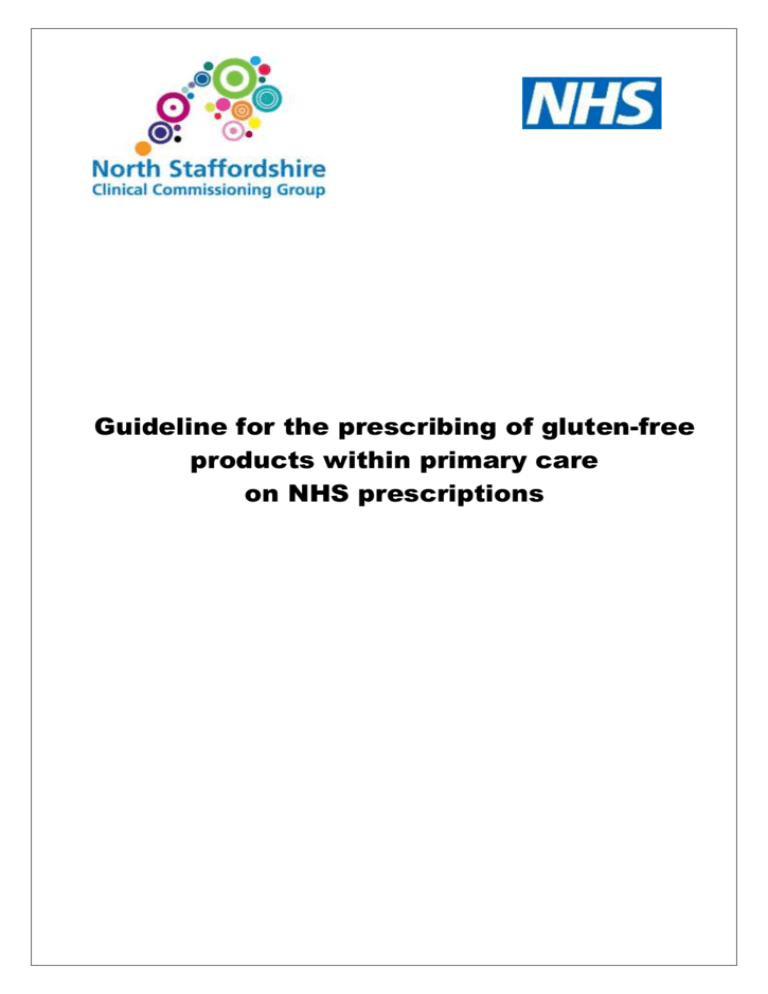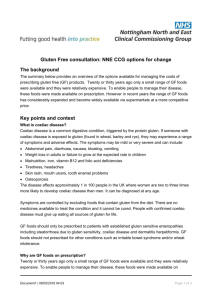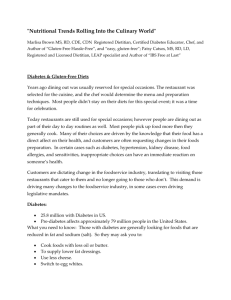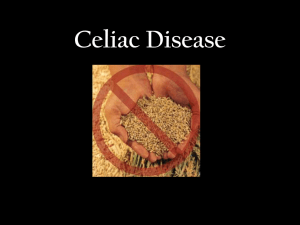gluten free prescribing guidelines 2011
advertisement

Guideline for the prescribing of gluten-free products within primary care on NHS prescriptions CONTENTS 1 INTRODUCTION 1.1 Background 1.2 Purpose 1.3 Scope 3 3 3 3 2 DUTIES 4 3 PROCEDURE/COURSE OF ACTION REQUIRED 3.1 Presentation to Prescription – The Patient Process 3.1.1 Adults 3.1.2 Children and adolescents (< 16 years of age) 3.2 Prescribing of Gluten-Free Foods on NHS prescriptions 3.3 Quantities of Gluten-Free Foods to be prescribed 4 4 5 5 6 6 4 IMPLEMENTATION 4.1 Training and awareness 4.2 Audit and monitoring 4.3 Information for Patients 8 8 8 8 5 REFERENCES 9 110825 NS CCG - Guidelines for the prescribing of Gluten–free products v1 FINAL 2 1 INTRODUCTION 1.1 Background NHS North Staffordshire has a legal responsibility to provide comprehensive, effective and accessible health services to its population within a finite resource, which includes the provision of prescribed foods for patients who require special diets. Coeliac disease is a common life-long condition with a prevalence of about 1% in Europe (Coeliac UK, 2004). The cornerstone of treatment is a gluten-free diet and patients require regular support from a registered dietician. ‘Coeliac disease is an inflammatory condition of the small intestinal mucosa that is induced by the ingestion of gluten and which improves clinically and histologically when gluten is excluded from the diet’ (British Society of Gastroenterology, 2010) In untreated coeliac disease, damage to the surface of the small intestine results in reduced ability to digest and absorb food and causes malabsorption of essential nutrients such as iron, folic acid and calcium. This can lead to a variety of health problems including diarrhoea, anaemia, reduced appetite, weight loss, mouth ulcers, abdominal bloating / distension and faltering growth in childhood (Coeliac UK, 2004). Coeliac disease is unique among gastrointestinal disorders in the availability of an effective dietary treatment that will restore almost all patients to full health, and help to protect against the development of complications (Coeliac UK, 2004). Coeliac disease requires life-long exclusion of gluten from the diet and dietary compliance is essential to successful management. However, some patients with coeliac disease may require with other dietary exclusions in addition to gluten-free, e.g. wheat and lactose. Any other medical conditions, e.g. diabetes and osteoporosis, should also be taken into account. During the period of 2010-2011, North Staffordshire spent just over £130,000 on gluten-free products, this represents an increase of 22% from 2009-2010. 1.2 Purpose The purpose of this Guideline is to support the standardisation of prescribing of gluten-free foods in primary care ensuring best practice and consistency across all GP practices. The Guideline will apply to the following groups of patients: People with coeliac disease requiring only gluten-free foods Individual authorised prescribers will continue to be legally responsible for their decisions and any consequences. 1.3 Scope All GP practices in the North Staffordshire area are expected to incorporate this Guideline into their practice procedures and the Medicines Management Team will monitor practice performance in line with this Guideline on a quarterly basis. GP practices are expected to review their prescribing to keep within this Guideline. 110825 NS CCG - Guidelines for the prescribing of Gluten–free products v1 FINAL 3 2 DUTIES The Medicines Management Team is responsible for supporting the implementation of this Guideline across North Staffordshire. 3 PROCEDURE / COURSE OF ACTION 3.1 Presentation to Prescription – The Patient Process Patients with a diagnosis of coeliac disease will be managed by a multi-disciplinary team across both primary and secondary care including GP, practice nurse, gastroenterologist / paediatric gastroenterologist, registered dietician (adult / paediatrics) and pharmacist. All patients receiving prescriptions for gluten-free foods should have had a CONFIRMED diagnosis from a Gastroenterologist / Paediatric Gastroenterologist - see tables 3.1.1 and 3.1.2 Any gluten-free foods being prescribed for patients without a confirmed diagnosis should be stopped. People with coeliac disease should avoid all foods containing gluten, a protein found in wheat, rye and barley. NB Sensitivity to oats varies between individual adults – advice on inclusion or exclusion should be sought from the patient’s registered dietician; oats should always be excluded from the diets of children diagnosed with coeliac disease. A gluten-free diet requires the avoidance of any food made from ingredients containing gluten such as bread, flour, pasta, cakes, pastries and biscuits. There are many other foods including ready meals and manufactured meat products such as sausages which can often contain gluten, e.g. cereals used as fillers. People with coeliac disease obtain gluten-free foods from a variety of sources including GP (FP10 prescription), supermarket, health food shop, pharmacy and mail order / telephone / internet. 110825 NS CCG - Guidelines for the prescribing of Gluten–free products v1 FINAL 4 3.1.1 Adults with Coeliac Disease Reference – Coeliac UK (2004), Gluten-free foods: a prescribing guide 3.1.2 Children and adolescents (< 16 years of age) Reference – Coeliac UK (2004), Gluten-free foods: a prescribing guide 110825 NS CCG - Guidelines for the prescribing of Gluten–free products v1 FINAL 5 3.2 Prescribing of Gluten-Free Foods on NHS Prescriptions The range of products available for prescribing nationally is listed in Part XV of the Drug Tariff (Borderline Substances). These include a variety of gluten-free bread / rolls, crackers and crispbreads, flour / flour-type mixes, pasta, pizza base (staple food replacements). Other gluten-free products such as biscuits, cereals, cakes/cake mixes, luxury breads and ready meals are also available from all supermarkets and patients should purchase these if required– they should no longer be prescribed on FP10. NB These products are widely available in shops and are not considered essential to the diet; they are also contrary to NHS recommendations for eating for health. NB Registered dieticians may, on occasions, request additional prescribable gluten-free ‘staple’ foods and / or gluten-free foods that fall outside the agreed ‘staple food’ list. This will be based on a full and detailed dietary assessment of an individual patient’s specific clinical needs, e.g. underweight adult or child requiring additional energy / nutrients. The registered dietician will be responsible for regularly reviewing the patient and advising their GP of any ongoing need for these additional gluten-free foods. It is good practice for patients to try a gluten-free food first before receiving a full month’s prescription; some manufacturers also offer sample packs. It can be difficult to estimate appropriate quantities of gluten-free foods to prescribe on repeat prescription – the following guidance will assist with this; it is also useful to ask the patient about quantities of gluten containing ‘staple’ foods (eg: bread, pasta, flour) eaten per month before they started experiencing symptoms. Also consider the patient’s skills and facilities for cooking. NB A gluten-free loaf is a different size to an ‘ordinary’ loaf of bread – remember to adjust for this when working out quantities to prescribe. Having agreed on a list of products, it is important to provide patients with flexibility to change items. A person’s need for food often changes over time, and they may wish to try new items – it is recommended to switch like for like products on their repeat medication list. Large quantities of gluten-free foods should not be prescribed as many products are difficult to store and expiry dates vary causing excessive wastage. Prescribing should be for a maximum of ONE MONTH at a time. 3.3 Quantities to be prescribed The following tables provide guidance on the monthly amount of prescribable gluten-free food, calculated in units based on energy and nutrient requirements of different age groups and genders. Additional amounts have been added for high levels of physical activity, breastfeeding and the third trimester of pregnancy. This guidance is based on: National nutritional recommendations and make assumptions that in addition to gluten-free food on prescription individuals eat naturally gluten-free carbohydrate food such as rice and potatoes Consumption data from the National Diet and Nutrition Surveys (Office for National Statistics and Medical Research Council Human Nutrition Research, 2002) and from individual records of NHS patients with coeliac disease The eat well plate (Food Standards Agency, 2007) where carbohydrates should provide 50% of total energy. 110825 NS CCG - Guidelines for the prescribing of Gluten–free products v1 FINAL 6 Age group Child 1-3 years 4-6 years 7-10 years 11-14 years 15-18 years 19-59 years 60-74 years 75+ years 19-74 years 75+ years Male Female Breastfeeding 3rd trimester High physical activity level Maximum number of units of gluten- free foods per month 10 11 13 15 18 18 16 14 14 12 Add 4 units Add 1 unit Add 4 units The number of units represented by the prescribable item is as follows: Item 400g loaf 400g rolls / baguettes 500g bread mix/ flour 200g crackers / crispbreads 500g pasta 2 x 110-180g pizza base Number of units 1 1 2 1 2 2 References: Coeliac UK (January 2011) British Dietetic Association (BDA), Primary Care Society for Gastroenterology (PCSG), Coeliac UK (2004) Some patients may be receiving in excess of this guidance and some people may be receiving less. The unit recommendations are based on national nutritional recommendations and the amount of products prescribed should follow this guidance and should only be exceeded in exceptional circumstances, based on the advise of a registered dietitian (adult / paediatric) or the patient’s doctor / Gastroenterologist / Pediatrician or Paediatric Gastroenterologist. NB Registered dieticians may, on occasions, request additional prescribable gluten-free ‘staple’ foods and / or gluten-free foods that fall outside the agreed ‘staple food’ list. This will be based on a full and detailed dietary assessment of an individual patient’s specific clinical needs, e.g. underweight adult or child requiring additional energy / nutrients. The registered dietician will be responsible for regularly reviewing the patient and advising their GP of any ongoing need for these additional gluten-free foods. Example: Elderly female aged 75 years: On questioning, the patient is sedentary, eating a well balanced diet and normal weight (Body Mass Index 20). Enjoys most foods but dislikes pasta, and has a good appetite in general. Suggested prescription = 12 units of gluten-free foods per month 6 x 400g loaves of bread = 6 units 2 x 400g rolls = 2 units 2 x200g crackers = 2 units 1 x 200g crispbreads = 1unit 1 x 400g baguette = 1 unit 110825 NS CCG - Guidelines for the prescribing of Gluten–free products v1 FINAL 7 Clinician’s should use their discretion in cases where nutritional intake is at risk. There may be cases where crackers should be prescribed instead of bread, for example, for older patients with dental problems or biscuits are recommended for individuals who are underweight or additional units are recommended in patients with additional calorie requirements. A registered dietitian is best placed to assess individual requirements. (Coeliac UK, January 2011) 4 IMPLEMENTATION Successful implementation of this Guideline requires a clear understanding and communication across our primary care setting. Successful in this context means that the appropriate gluten-free ‘staple’ foods are prescribed within the recommended unit allocation for each confirmed diagnosed of coeliac disease. 4.1 Training and awareness Healthcare professionals can be supported to understand and apply the principles of this Guideline by the Medicines Management Team. The Guideline should also be introduced to all practice staff at their local practice meetings. 4.2 Audit and monitoring The Medicines Management Team will need to ensure that audit strategies are in place in order for the CCG to be assured that this Guideline is being followed appropriately. Practices, supported by the Medicines Management Team, will undertake an initial audit to highlight patients whose current medication does not fit within this Guideline. A list of recommendations will then be given to each practice along with any other findings found within the audit. The team will then monitor concordance by looking at quarterly prescribing habits. 4.3 Information for Patients Information to any patients affected by this Guideline will be disseminated via letters to their home address; included in this will also be a contact number for a member of the Medicines Management Team. Patients will be encouraged to call with any queries or questions that they may have regarding changes to their gluten-free foods. 110825 NS CCG - Guidelines for the prescribing of Gluten–free products v1 FINAL 8 5 REFERENCES British Society of Gastroenterology (2010) The Management of adults with coeliac disease. http://www.bsg.org.uk/sections/small-bowel-nutrition-articles/bsg-guidance-on-coeliac-disease-2010.html Coeliac UK, January 2011. Prescribing of gluten-free foods: Coeliac UK’s position. http://www.coeliac.org.uk/healthcare-professionals/healthcare-professional-newsletters/january-2011professional-exg/prescribi British Dietetic Association (BDA), Primary Care Society for Gastroenterology (PCSG), Coeliac UK (2004). Gluten-free foods: A Prescribing Guide. Office for National Statistics and Medical Research Council Human Nutrition Research (2002). The National Diet & Nutrition Survey: adults aged 19 to 64 years (2002) Types and quantities of foods consumed. A survey carried out in Great Britain on behalf of the Food Standards Agency and the Department of Health. Food Standards Agency (2007). Eat Well Plate. The Guideline has been developed with professional guidance from the Strategic Professional Lead – Dietetics, South Staffordshire PCT (Provider Services) This Guideline was adapted from South Staffordshire Primary Care Trust. . 110825 NS CCG - Guidelines for the prescribing of Gluten–free products v1 FINAL 9





